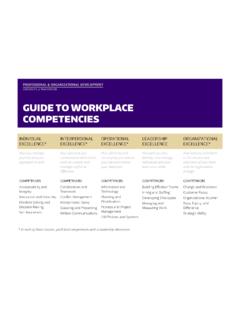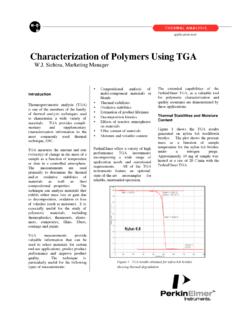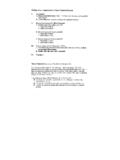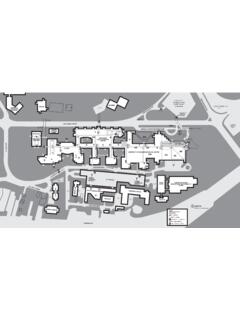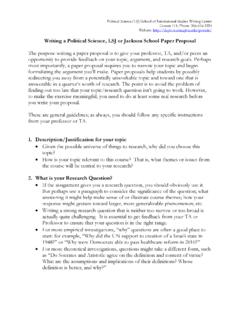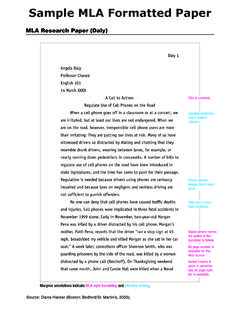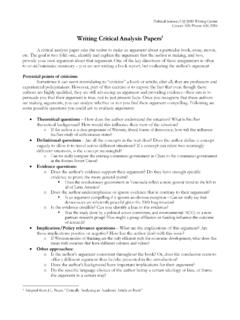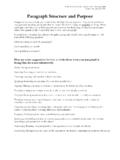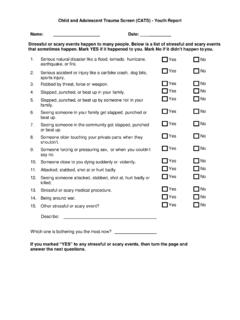Transcription of 10 benefits of the WTO trading system
1 1 The world is booklet highlights some of the benefits of theWTO s multilateral trading system , but it doesn t claim that everything isperfect otherwise there would be no need for further negotiations and forthe rules to be does it claim that everyone agrees with everything in the WTO. That sone of the most important reasons for having the system : it s a forum forcountries to thrash out their differences on trade said,there are many over-riding reasons why we re better off with thesystem than we would be without it. Here are 10 of 10 benefits1. The system helps promote peace2. Disputes are handled constructively3. Rules make life easier for trade cuts the costs of provides more choice of products and qualities6. Trade raises stimulates economic basic principles make life more efficient9.
2 Governments are shielded from lobbying10. The system encourages good government10 benefits of the WTO trading systemPeace is partly an outcome of two ofthe most fundamental principles ofthe trading system : helping trade toflow smoothly, and providingcountries with a constructive and fairoutlet for dealing with disputesover trade issues. It is also anoutcome of the internationalconfidence and cooperationthatthe system creates and is littered with examples oftrade disputes turning into war. Oneof the most vivid is the trade war ofthe 1930s when countries competedto raise trade barriers in order toprotect domestic producers andretaliate against each others worsened the Great Depressionand eventually played a part in theoutbreak of world War developments immediately afterthe Second world War helped toavoid a repeat of the pre-war tradetensions.
3 In Europe, internationalcooperation developed in coal, and iniron and steel. Globally, the GeneralAgreement on Tariffs and Trade (GATT) was have proved successful, so muchso that they are now considerablyexpanded one has become theEuropean union , the other the WorldTrade Organization (WTO). HOW DOES THIS WORK?Crudely put, sales people are usuallyreluctant to fight their customers usually. In other words, if trade flowssmoothly and both sides enjoy ahealthy commercial relationship,political conflict is less s more, smoothly-flowing tradealso helps people all over the worldbecome better off. People who aremore prosperous and contented arealso less likely to that is not all. The GATT/WTOsystem is an important trade wars in the 1930sare proof of how protectionism caneasily plunge countries into a situationwhere no one wins and short-sighted protectionist view isthat defending particular sectorsagainst imports is beneficial.
4 But thatview ignores how other countries aregoing to respond. The longer termreality is that one protectionist step byone country can easily lead toretaliation from other countries, a lossof confidence in freer trade, and aslide into serious economic trouble forall including the sectors that wereoriginally protected. Everyone is the key to avoiding thatkind of no-win scenario. Whengovernments are confident that otherswill not raise their trade barriers, theywill not be tempted to do the will also be in a much betterframe of mind to cooperate with WTO trading system plays a vitalrole in creating and reinforcing thatconfidence. Particularly important arenegotiations that lead to agreementby consensus, and a focus on abidingby the sounds like an exaggerated claim, and it would be wrong to maketoo much of it.
5 Nevertheless, the system does contribute to internationalpeace, and if we understand why, we have a clearer picture of what thesystem actually The system helps to keep the peace2 Sales people areusually reluctant tofight their customers2. There could be a down side to tradeliberalization and expansion. Moretrade means more opportunities fordisputes to arise. Left to themselves,those disputes could lead to seriousconflict. But in reality, a lot ofinternational trade tension is reducedbecause countries can turn toorganizations, in particular the WTO,to settle their trade world War 2 that option wasnot available. After the war, theworld s community of trading nationsnegotiated trade rules which are nowentrusted to the WTO. Those rulesinclude an obligation for members tobring their disputes to the WTO andnot to act they bring disputes to theWTO, the WTO s procedure focusestheir attention on the rules.
6 Once aruling has been made, countriesconcentrate on trying to comply withthe rules, and perhaps laterrenegotiating the rules not ondeclaring war on each over 100 disputes have beenbrought to the WTO since it was setup in 1995. Without a means oftackling these constructively andharmoniously, some could have led tomore serious political fact that the disputes are basedon WTO agreements means that thereis a clear basis for judging who is rightor wrong. Once the judgement hasbeen made, the agreements providethe focus for any further actions thatneed to be trade expands in volume, in the numbers of products traded, and inthe numbers of countries and companies trading , there are moreopportunities for trade disputes to arise. The WTO system helps resolvethese disputes peacefully and system allows disputes to behandled constructively3 Countries in disputealways aim to conformwith the agreementsThe increasing number of disputesbrought to GATT and its successor,the WTO, does not reflect increasingtension in the world .
7 Rather, it reflectsthe closer economic ties throughoutthe world , the GATT/WTO s expandingmembership and the fact thatcountries have faith in the system tosolve their the exchanges betweenthe countries in conflict can beacrimonious, but they always aim toconform with the agreements andcommitments that they in the WTO are made byconsensus. The WTO agreementswere negotiated by all members, wereapproved by consensus and wereratified in all members agreements apply to and poor countries alike can bechallenged if they violate anagreement, and they have an equalright to challenge others in the WTO sdispute settlement of the opportunities to formalliances and to pool are already doing are matching benefits for largercountries. The major economicpowers can use the single forum ofthe WTO to negotiate with all or mostof their trading partners at the sametime.
8 This makes life much simpler forthe bigger trading countries. Thealternative would be continuous andcomplicated bilateral negotiationswith dozens of countriessimultaneously. And each countrycould end up with different conditionsfor trading with each of its tradingpartners, making life extremelycomplicated for its importers andexporters. The principle of non-discriminationbuilt into the WTO agreements avoidsthat complexity. The fact that there isa single set of rules applying to allmembers greatly simplifies the entiretrade WTO cannot claim to make all countries equal. But it does reducesome inequalities, giving smaller countries more voice, and at the sametime freeing the major powers from the complexity of having to negotiatetrade agreements with each of their numerous trading The result for smaller countries issome increased bargaining a multilateral regime such asthe WTO s system , the more powerfulcountries would be freer to imposetheir will unilaterally on their smallertrading partners.
9 Smaller countrieswould have to deal with each of themajor economic powers individually,and would be much less able to resistunwanted addition, smaller countries canperform more effectively if they makeA system based on rules rather than power makeslife easier for all4 Smaller countries enjoymore bargaining power,and life is simpler forbigger countriesWe are all prices we pay for our food and clothing, ournecessities and luxuries, and everything else in between, are affected bytrade is expensive: it raisesprices. The WTO s global systemlowers trade barriers throughnegotiation and applies the principleof non-discrimination. The result isreduced costs of production (becauseimports used in production arecheaper) and reduced prices offinished goods and services, andultimately a lower cost of are plenty of studies showingjust what the impacts of protectionismand of freer trade are.
10 These are just afew figures:FOOD IS CHEAPER When you protect your agriculture,the cost of your food goes up by anestimated $1,500 per year for a familyof four in the european union ; by theequivalent of a 51% tax on food inJapan; by $3 billion per year added toUS consumers grocery bills just tosupport sugar in one year (1988).Negotiating agricultural trade reformis a complex are still debating theroles agricultural policies play in arange of issues from food security toenvironmental WTO members are now reducingthe subsidies and the trade barriersthat are the worst offenders. Theyhave agreed to start new negotiationsat the turn of the ARE CHEAPERI mport restrictions and high customsduties combined to raise US textilesand clothing prices by 58% in the consumers pay an estimated 500million more per year for theirclothing because of these Canadians the bill is aroundC$780 million.
